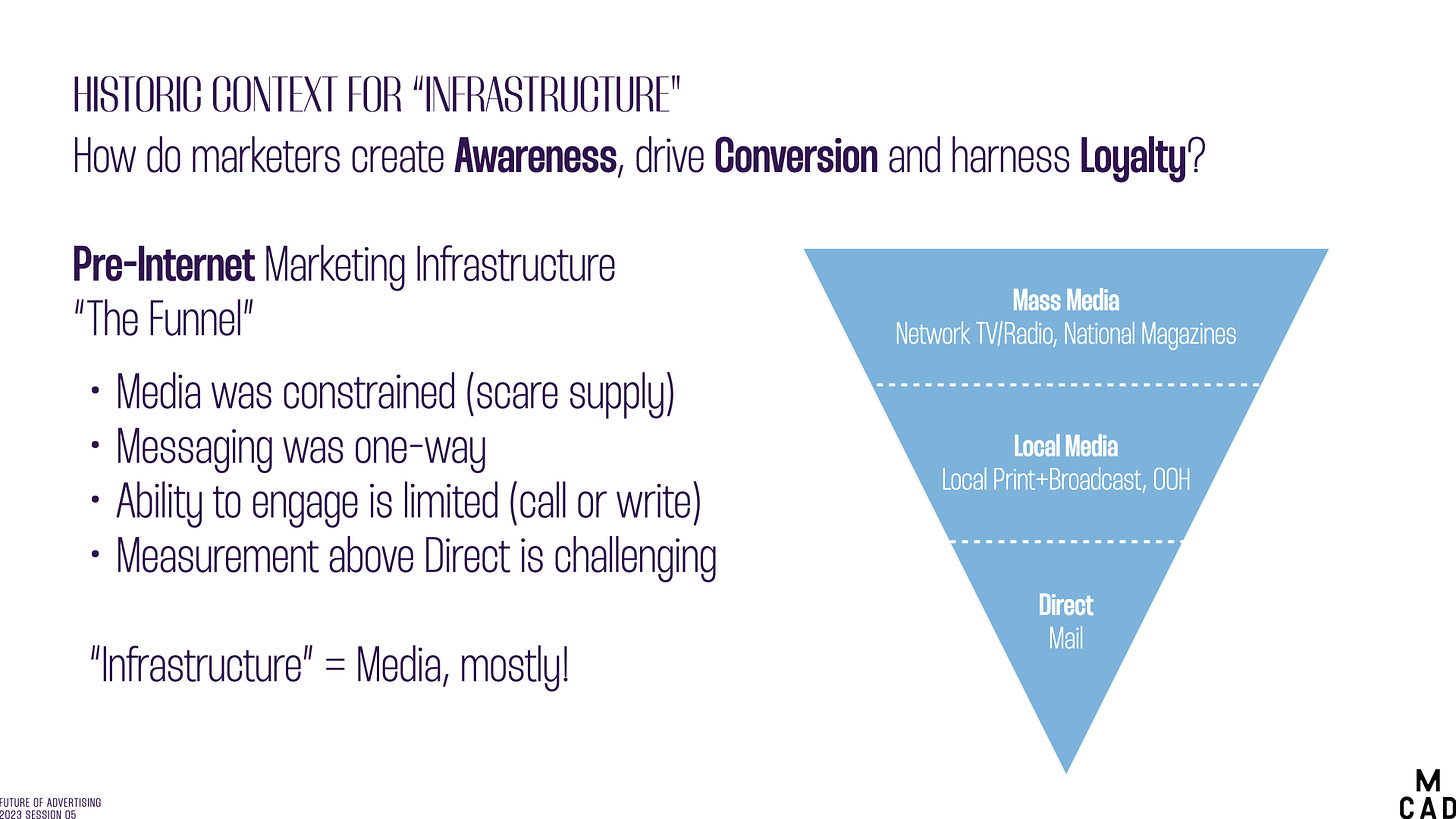016: Infrastructure is rarely constant
[During - Session 5] And I made my class watch a 10-minute TikTok
Preamble: I am assuming you are on TikTok. Has Hilton’s 10-minute TikTok arrived on your For You page yet? Given today’s media environment, I think it’s brilliant for a few reasons:
The length of this idea on this specific platform is absurdly appropriate. Solid comms planning.
It’s cost efficient: Imagine the price to communicate the same points seen in this ten minute ad across broadcast TV. And it’s targeted: the audience Hilton’s brands need to persuade is on TikTok, not TV.
Once they established “we’re in for ten minutes” Hilton dramatizes multiple relevant creative briefs… i.e. Hilton’s portfolio of brands (likely unknown to most); various amenities across brands, and historical brand DNA; and, most importantly—the laundry list of reasons for the audience to avoid Hilton’s biggest competition—AirBnB, et al.
My favorite moment is when the old (Boomer?) white guy marketer bemoans, “Why can’t we just make normal TV commercials?!”
Because the infrastructure of marketing and advertising is changing, friends. It’s true: digital content and commerce technologies have generally stabilized (when compared with a decade ago); the mechanics of social have matured; and mobile broadband has unlocked reliable consistency. But...
Advertising’s infrastructure isn’t just technical. It’s cultural and generational.
EY calls right now the, “era of great disruption.” The Webby Awards 2023 Trend Report says, “Younger Internet users are leading a diversification of platforms. They are shifting away from Internet monoculture (think: legacy platforms and sites) in favor of niche networks.” And Accenture’s Life Trends 2023 fills in the emotional gaps, “If we think of life as seismic waves, until a few years ago, things seemed to hum along quite nicely (in most places) with the occasional spike here and there. Now, though, the shocks feel relentless and wild, and sometimes it’s extremely unsettling.” Accenture continues (emphasis mine), “As growing numbers of people internalize instability as a norm, the way they adapt will affect what they buy, and how they view brands.”
Of course, we’ve been here before.
I’m Gen X. I grew up watching a black and white TV. My neighbor had Pong. Decades sped past with little if any real change in the infrastructure of marketing and advertising, i.e. “The Funnel.” The simplicity of few major media channels helped emphasize the purity of concepts and ideas. I witnessed entire careers spent crafting inside the funnel.
Then Al Gore invented the Internet.
Talk about internalizing instability as a norm. I still think we’re struggling with the shift to inter-action, and the speed with which subsequent technologies and culture intertwine and subvert each other. All of a sudden, what constituted marketing’s infrastructure moved from being literally just media investment to “owned” hardware and software.
As I wrote before this course began: “Our predecessors never had to architect and code the medium their ideas would live within.” (If you need more: Paul Ford’s 2015 opus for Bloomberg—”What Is Code?” remains relevant, useful reading.)
And a bittersweet eulogy to Web1: We collectively decided the Internet was a direct marketing vehicle.
Then, just as that first decade of disruption began to settle—Zuck evolved his business model, others joined in, the iPhone took off and marketing infrastructure began a second reorganization centered around the notion of social and mobile.
Web2 began as a Millennial age, and will continue to evolve past Gen Z, defining marketing infrastructure as a hodgepodge, a knitting together of various platforms and communities—measured and optimized, often in real time.
The pre-Internet norms continue to shatter: Is a brand its packaging on Amazon’s digital shelf, or its broadcast content, or its website, or its e-comm flow within Instagram, or its community on Twitch, or Discord, or its newsletter subscribers, or its latest experiential pop up, or whatever it enables via Salesforce or Hubspot? Likely all of the above, of course.
Now it’s time to speed everything up while we reinvent it!
Yes, plenty of innovative technology is emerging to suggest what Web3 and the future of advertising’s infrastructure will look like. But culture seems a more potent driver—what will Generation Alpha aspire to, that previous cohorts might enable and standardize? That’s good news for my students: They get a front row seat, and the option to help drive the metaphoric bus if that’s what they choose.
Many thanks to this evening’s guest Jason Grey (LinkedIn), for illuminating how marketing infrastructure works; and for articulating the kinds of questions we should ask of technology and technologists, especially as we evaluate ideas in their initial stages.
We ended class #5 with the infamous “S” curve, via Faris Yakob’s July 2022 POV in WARC: Advertising in the age of mechanical creation. As Faris put it, “We have just lived through the most important consumer media S-curve since the adoption of the printing press, at the nexus of social media, smartphones and wireless connectivity.”
My question to the students: What new marketing infrastructure will emerge and expand upon the legacies of technologies like the iPhone, including all that is social media and 5G broadband connectivity? And what role will all of us play in that forthcoming evolution?
Our final quote comes via Andreessen Horowitz’s General Partner Chris Dixon, circa 2010, somewhat in response to the iPhone.
“The next big thing will start out looking like a toy.”
Have we heard this yet, re: AI-generative technology?
“…and we are not really ready,”
responds Wharton prof
just a few days ago.Okay, two quotes tonight!
I’ll have an “After” reflection on class #5 sometime this Wednesday.
Next week we’ll dive into our third major theme of the future of advertising: Social/Media + Influence & Affiliation, with a very special guest.











